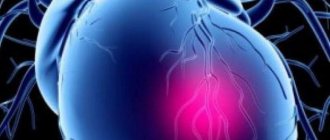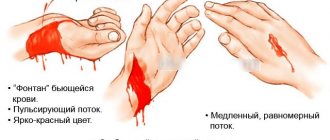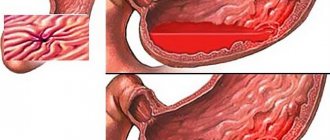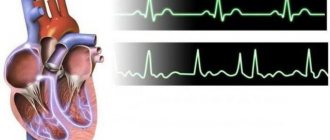The cardiovascular system is characterized by significant adaptability, however, emergency conditions are possible due to defects in the functioning of one or more elements of the anatomical structure.
Cardiogenic shock is an emergency condition accompanied by a sharp disturbance in the intensity of cardiac (left ventricular) output.
Blood pressure drops sharply, becoming critical. Usually these numbers are below 90 to 60. Hypertensive patients suffer from an even more severe condition due to consistently high working pressure.
In the absence of urgent resuscitation care, rapid death occurs due to cardiac arrest or heavy bleeding (for example, due to myocardial rupture).
The causes of the condition are varied, but almost always have a cardiac origin. The process is accompanied by a lot of dangerous symptoms.
Cardiogenic shock itself can provoke secondary disabling complications.
Before transporting the patient, initial care measures must be taken. Which ones exactly, and what do you need to know about cardiogenic shock in order to be prepared?
Types of conditions and characteristic symptoms of cardiogenic shock
Among the types of emergency conditions described are:
- Shock due to myocardial rupture. The most dangerous clinical condition. Develops due to a violation of the anatomical integrity of the cardiac structures. Blood flows into the pericardium, further impairing contractile function (so-called cardiac tamponade).
The pathology is accompanied by the following symptoms: intense chest pain, difficulty breathing, cold sweat, darkening of the eyes and loss of consciousness (in most cases), severe headache, etc.
- Reflex type. It develops as a result of an intense painful stimulus, for example, with insufficient anesthesia during surgery. It poses almost no danger, since it can be easily removed even with improvised means.
Clinical symptoms of cardiogenic shock: chest pain, loss of consciousness, darkening of the eyes, tinnitus, disorientation in space.
- A true shock. Caused by heart failure. Unfortunately, the mortality rate of this condition approaches 100%, since pathological mechanisms lead to disorders of a nature incompatible with life. First aid will not help, nor will resuscitation measures.
- Arrhythmic shock. It is a special case of a cardiogenic emergency. Associated with heart rate disturbances such as bradycardia or paroxysmal tachycardia.
It can be stopped, but only in a hospital setting. Signs of cardiogenic shock: chest pain, shortness of breath, suffocation, arrhythmias, headaches, fainting (syncope).
- Areactive shock state. Similar to the true variety, but the lethality is even higher, there is no chance at all, since the pathogenetic mechanisms develop in a matter of minutes. Often doctors do not even have time to provide first aid.
Thus, cardiogenic shock of any form is associated with the following clinical symptoms:
- Intense headache. It ticks, accompanies every heartbeat.
- Arrhythmia. According to the type of acceleration of cardiac activity or bradycardia (reverse process). It cannot be controlled even with prescribed medications.
- The pain behind the sternum is strong, pressing, and does not allow you to take a single breath.
- Shortness of breath and suffocation.
- Darkening in the eyes.
- Disorientation in space.
- Loss of consciousness (fainting).
- Hyperhidrosis (cold sweat).
- Paleness of the dermis.
- Renal dysfunction is a characteristic manifestation (oliguria is observed, that is, the volume of daily urine is reduced to 20 ml per hour). Complete absence of urine or anuria is also possible.
The level of blood pressure in cardiogenic shock varies widely, critical is 90/60 mm Hg. Art.
Intensive therapy of arrhythmogenic shock
Arrhythmogenic shock is a type of circulatory disorder in which adequate blood supply to organs and tissues is impaired due to an imbalance in the heart rate. Arrhythmia can be primary or secondary. Primary disorders include rhythm and conduction disorders caused by abnormalities in the development of the conduction system. Secondary arrhythmia is associated with cardiomyopathy, fibroslastosis, organic lesions and myocardial metabolic disorders, and electrolyte disturbances. Based on the location of the pathological pacemaker, supraventricular (atrial and nodal) and ventricular arrhythmias are distinguished. There are also tachy- and bradyarrhythmias . The main pathogenetic mechanism of tachyarrhythmic shock is a shortening of the diastolic filling time of the heart and a decrease in stroke output against the background of a reduction in the diastolic period of coronary blood flow.
In bradyarrhythmic shock, a decrease in cardiac output cannot be compensated by an increase in stroke output, since the volume of diastolic filling of the ventricles is limited by the ability of the myocardial wall to mechanical stretch.
A preliminary diagnosis of arrhythmia is established based on palpation of the pulse in the femoral or carotid arteries, auscultation of the heart and the presence of hypertension. Symptoms such as a sudden change in the child’s condition, restlessness or lethargy (blockade of the atrioventricular junction), loss of consciousness (Edams-Stokes syndrome), acrocyanosis, pallor of the skin, and “marbled” skin pattern can be used to suspect arrhythmia. An accurate diagnosis is established based on ECG data.
Arrhythmogenic shock can develop against the background of excessive sinus, atrial and ventricular tachycardia, ventricular fibrillation, bradyarrhythmia (idioventricular rhythm, atrioventricular block II - III degree), ventricular extrasystoles.
Treatment of arrhythmogenic shock involves emergency restoration of heart rhythm at a rate that ensures adequate cardiac output. A prerequisite for the treatment of tachy- and bradyarrhythmic shock is the elimination of arrhythmogenic factors: the negative influence of the vagus nerve, hypoxia, acidosis, alkalosis, and electrolyte disturbances. The use of antiarrhythmic drugs should be preceded by correction of hypo- and hypervolemia, anemia, hypoglycemia and mandatory atropinization at the rate of 0.01-0.03 mg/kg body weight. The priority means of emergency treatment of tachyarrhythmic shock is electrodepolarization (2 W/s per 1 kg of body weight), which allows you to gain time and select the optimal antiarrhythmic pharmacological agent. For supraventricular tachyarrhythmia, it is preferable to administer isoptin - 0.1 mg/kg over 1 minute. The same dose can be prescribed again at 15-minute intervals. Lidocaine is prescribed at a dose of 1 mg/kg and administered over 10 minutes. Mexitil is effective for ventricular tachyarrhythmia and extrasystole. The drug is administered at a dose of 5 mg/kg over 15 minutes, a maintenance dose of 5–20 mcg/kg per minute.
In case of bradyarrhythmic shock and there is no effect from the administration of atropine sulfate, the drug of choice is Isuprel (isoproterenol, isadrin, novodrin). If there is no effect from drug therapy, cardiac pacing is indicated.
All children in a state of arrhythmogenic shock are hospitalized in the intensive care unit.
First aid algorithm - what you can do yourself
First aid must be provided quickly. Delays reduce the patient's chances of saving life.
The emergency care algorithm for cardiogenic shock includes the following steps:
- Place the patient on a couch or other hard surface. It is important that your head rests on a high pillow. Bend your legs at an angle of 15 degrees or so.
- Open a window or vent to ensure fresh air flows into the room.
- If the patient is unconscious, turn the head to the side to avoid choking on vomit (aspiration). Check to see if your tongue is stuck.
- Closely monitor your heart rate. In case of cardiac arrest, indirect massage is indicated at a speed of 100-120 compressions per minute. The force of impact should be maximum. Please note: rib fractures during first aid are not considered grounds for stopping resuscitation.
- There is no point in using pills. You cannot give medications on your own. The condition is serious, it is not known how the body will react to a dose of a tonic.
Thus, independent emergency care for cardiogenic shock: bringing the patient into a horizontal position, providing the body with oxygen, and in case of cardiac arrest - massage.
Nothing more can be done on our own, at the pre-hospital stage. It is necessary to call an ambulance as quickly as possible and indicate a probable cardiogenic shock so that the team can react in time.
Diagnosis of cardiogenic shock
The detection of shock is based on the typical clinical picture. Many difficulties arise in determining the cause of the patient’s condition, which affects the treatment regimen.
Doctors perform an ECG to determine the symptoms of a heart attack, the form of arrhythmia, and blockade. The examination is carried out immediately. If an ambulance is called, it is carried out at home. In the hospital, an ultrasound examination of the heart is performed to determine the decrease in contractile function of the ventricles. An x-ray helps identify pulmonary embolism, pulmonary edema, and affected cardiac circuits.
Carrying out an ECG of the heart
Classification of cardiogenic shock after studies helps to make an accurate diagnosis. During treatment, the level of oxygen saturation in the blood, the functioning of organs and other criteria are determined.
Under no circumstances should symptoms be ignored. The consequences of such connivance are sad, most often death. Its probability is already high, there is no need to increase it. It is important to immediately call an ambulance and follow some steps.
Reasons for developing an emergency condition
Factors in the development of shock are almost always of cardiac origin. Among the likely factors:
- Traumatic heart lesions. As a result of a bruise or fracture of the chest, disruption of the integrity of the ribs, etc. Accompanied by a change in local blood circulation and nutrition of the myocardium.
- Extensive infarction affecting about or more than half of the organ structures.
- Violation of the contractile function of the heart. Most often formed in chronic heart failure and coronary heart disease.
- Myocardial rupture. The most difficult phenomenon. Mortality even in the case of medical assistance is almost 100% due to the violation of the integrity of the organ.
- Myocarditis, endocarditis. Inflammatory lesions of the heart structures.
- Prolonged course of hypotension or hypertension. This is a late complication that poses a danger to health and life.
- History of viral or bacterial infections with high body temperature. Pathologies such as measles, herpes of the fourth and fifth types, diphtheria, tuberculosis, syphilis, AIDS and some others affect them.
- Rheumatism. History of rheumatoid arthritis.
The mortality rate of cardiogenic shock, regardless of the cause, varies between 75-100%. The chances of survival are quite low. However, hypotension itself is not considered the first sign of an emergency.
High-risk groups: patients with a history of diabetes mellitus, those suffering from long-term arrhythmia, elderly patients (over 60 years old), menopausal and postmenopausal women, subject to specific hormonal therapy, etc.
Children are not immune from pathology, but the likelihood of this scenario is extremely low.
Classification
- True;
- Peripheral vessels dilate, a drop in blood pressure occurs without severe damage to the myocardium itself - cardiogenic shock, its reflex form (complicates the course of posterior myocardial infarction with very severe pain);
- If there is no response to therapy in cardiogenic shock, they speak of its non-reactive form;
- true;
- reflex (development of pain collapse);
- arrhythmogenic;
- Areactive.
True cardiogenic shock. Pathogenesis of development
Depending on the cause and clinical picture, several types of cardiogenic shock are distinguished:
- true;
- areactive;
- reflex;
- arrhythmogenic.
| Clinical manifestations | 1st degree (mild) | 2nd degree (moderate) | 3rd degree (severe) |
| Duration of shock | less than 5 hours | from 5 to 8 hours | more than 8 hours |
| Blood pressure in mm Hg. Art. | at the lower limit of normal 90/60 or up to 60/40 | upper at 80-40, lower at 50-20 | not defined |
| Tachycardia (beats per minute) | 100–110 | up to 120 | dull tones, threadlike pulse |
| Typical symptoms | weakly expressed | left ventricular failure predominates, pulmonary edema is possible | pulmonary edema |
| Response to treatment | good | slow and unstable | absent or short-term |
Process diagnostics
Since we are talking about an emergency condition, there is no time for long thoughts and verification of the diagnosis. We need to do everything quickly.
Shock is diagnosed based on visual findings and some objective information:
- Heartache. Patients experience severe discomfort, complain, moan, and behave restlessly.
- The skin is pale, cold sticky sweat appears on the forehead.
- Body temperature below 36 degrees Celsius.
- Cyanosis of the nasolabial triangle (blue discoloration of the skin around the lips) is almost always present.
- There is shortness of breath and suffocation. Patients cannot take in air normally and suffocate.
- Tachycardia, bradycardia with an abnormal heartbeat (the pulse either quickens or slows down, there is no rhythm, it beats chaotically).
- Heart sounds (during auscultation) are muffled.
- A late sign of cardiogenic shock is a drop in blood pressure below 90 to 60, or by more than 30 mmHg. Art. below the individual norm.
- Dysuria, signs of renal dysfunction.
- History of cardiac diseases and endocrine pathologies. Most often senile age (60 years or more).
Before conducting a full diagnosis (ECG, ECHO-CG), it is necessary to put the patient in order and stabilize the condition. In the future, already in a hospital setting, you need to look for the root cause of the pathological process.
Causes
Usually, and most often in practice, shock occurs against a background of prolonged pain (several hours). Knowing the cause is more important than the type of pathological process itself. It is often obvious after reviewing the patient's medical history.
Some conditions of a patient in shock may indicate various serious complications.
Common reasons are:
- Myocardial infarction.
- Cardiac tamponade.
- Pulmonary embolism.
- Prolonged bed rest.
- Pancreatitis.
Arrhythmogenic shock can often occur for no apparent reason. To determine the exact “culprit” that provoked the pathology, doctors begin an immediate examination of the patient. They give him an X-ray of the sternum, an ECG, and examine blood gases. With good results, the likely cause may be drug overdose, rare infections, or obstructive shock.
ECG registration is important. The tactics are independent of the type of tachycardia, but in all cases electrical cardioversion is indicated.
Acute pancreatitis can cause serious complications. Pancreatogenic shock is the most dangerous consequence of this disease.
The causes and symptoms of toxic shock are described in detail here.
Despite the fact that donor material is checked for compatibility before blood transfusion, sometimes it happens that the recipient's body rejects the donor's blood. In this case, transfusion shock occurs. This topic details the symptoms of this condition and treatment methods.
Treatment
The consequences of cardiogenic shock are catastrophic even with a mild course of the process: the development of heart failure, coronary artery disease, myocardial damage and, as a result, disability is likely.
Treatment is required to prevent functional impairment and relapse.
Drugs from several pharmaceutical groups are prescribed:
- Thrombolytics to prevent blood clots.
- Medicines to normalize blood pressure. Including tonics or antihypertensive drugs. The combination is selected according to the situation.
- Intravenous infusions of saline and glucose to restore hemodynamics (blood circulation) and prevent congestion in the patient’s body.
In extreme cases, surgical treatment with correction of the anatomical integrity of the cardiac structures is indicated.
Attention:
Regular screening is carried out throughout the year. Every month after discharge you need to visit a cardiologist. Subsequently, every six months with constant adjustment of therapy.
An emergency situation changes the patient's life. If a person wants to continue living, he needs to give up bad habits. Eat right, get plenty of rest and avoid stress and physical activity. A specific scheme is developed only by a doctor.
Treatment after cardiogenic shock includes: restoration of electrolytic balance, normalization of oxygen concentration in the blood, provision of tissue nutrition, restoration of normal blood pressure and myocardial contractility, correction of heart rhythm. A system of measures is required.
Diagnostics
The symptoms of cardiogenic shock are pronounced, so there are no problems with making a diagnosis. First of all, resuscitation measures are carried out to stabilize the person’s condition, and only then diagnostics are carried out.
Diagnosis of cardiogenic shock includes the following procedures:
- chest x-ray;
- angiography;
- echocardiography;
- electrocardiography
- CT;
- blood chemistry;
- arterial blood sampling for analysis of gas composition.
Diagnostic criteria for cardiogenic shock are taken into account:
- heart sounds are muffled, a third tone can be detected;
- kidney function - diuresis or anuria;
- pulse - thread-like, small in filling;
- blood pressure indicators are reduced to a critical minimum;
- breathing - shallow, labored, with a high rise of the chest;
- pain - sharp, throughout the chest, radiating to the back, neck and arms;
- human consciousness - semi-delirium, loss of consciousness, coma.
Based on the results of diagnostic measures, treatment tactics for cardiogenic shock are selected - medications are selected and general recommendations are drawn up.
Forecast
Directly depends on the degree of development of cardiogenic shock. In mild cases, the survival rate is 20%; with proper actions, you can minimize the likelihood of developing heart failure in the future. But relapses are possible, which turn out to be fatal.
- Moderate grade is associated with 50% mortality. It is not easy to relieve this condition; relapse occurs in the first few days.
- A severe form completely deprives the patient of any hope of survival. Mortality is close to 100%. Even if life is preserved, patients die from heart failure in the first few years.
- The most dangerous period is the first 2-3 days.
In Europe, the mortality rate is 50%. In Russia and the CIS countries, due to insufficient qualifications of doctors and technical insecurity - 70-80%. Even successful stabilization of the condition is not a guarantee of further survival.
Etiology
In most cases, cardiogenic shock develops during myocardial infarction as a complication. But there are other etiological factors for the development of the anomaly. The causes of cardiogenic shock are as follows:
- complication after myocarditis;
- poisoning with cardiac substances;
- pulmonary embolism;
- intracardiac bleeding or effusion;
- poor pumping function of the heart;
- severe arrhythmia;
- acute valvular insufficiency;
- hypertrophic cardiomyopathy;
- rupture of the interventricular septum;
- aortic stenosis;
- pneumothorax;
- traumatic or inflammatory damage to the pericardial sac.
Causes of cardiogenic shock
Any condition is extremely life-threatening, so if you have a diagnosis, you need to carefully follow the doctor’s recommendations, and if you feel unwell, urgently seek medical help.











